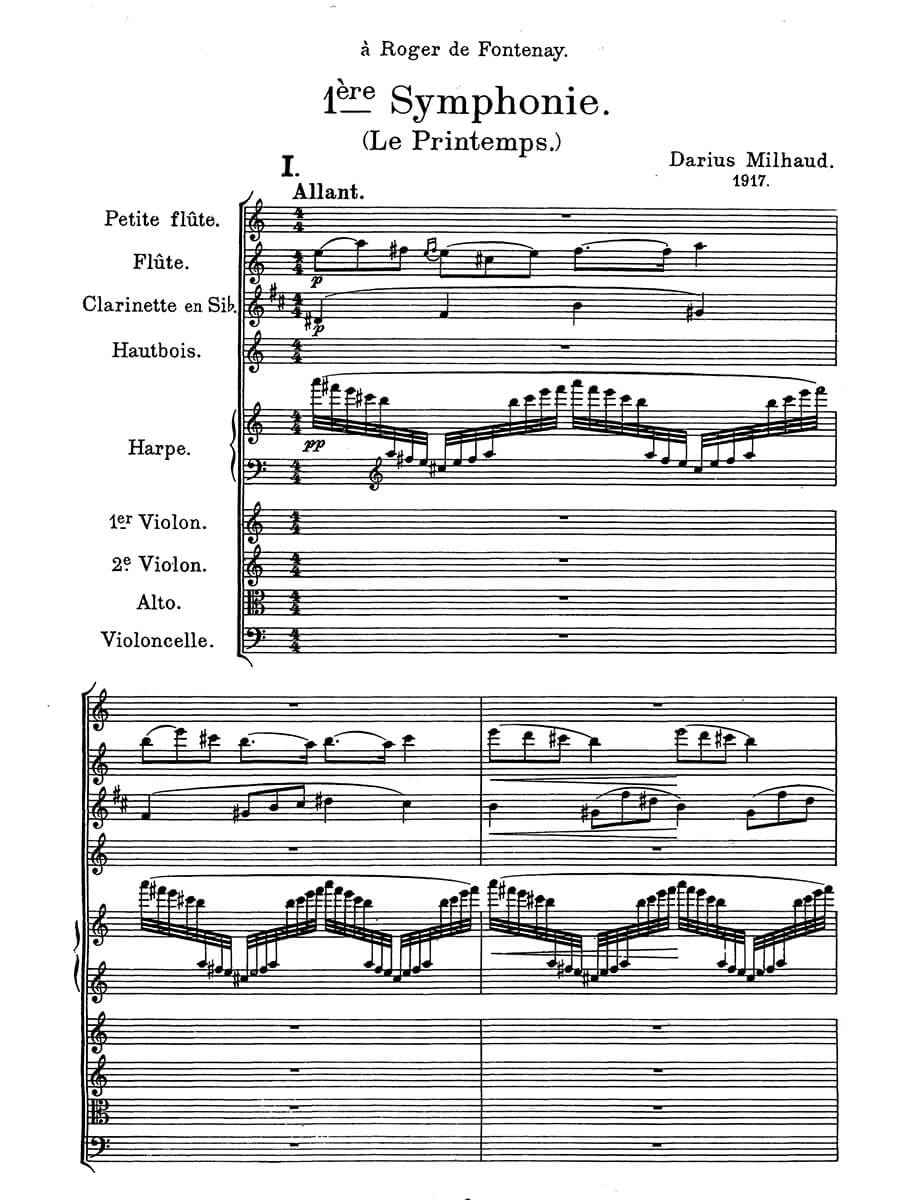Cinq Symphonies de Chambre
Milhaud, Darius
27,00 €
Darius Milhaud – Cinq Symphonies de Chambre (1917-22)
(b. Marseille, 4 September 1892 – d. Geneva, 22 June 1974)
Ière Symphonie – Le Printemps (p. 1)
IIème Symphonie – Pastorale (p. 17)
IIIème Symphonie – Sérénade (p. 33)
IVème Symphonie – Dixtuor à cordes (p. 47)
Vème Symphonie – Dixtuor à vents (p. 67)
Preface
Darius Milhaud enrolled at the Paris Conservatoire in 1910 where he studied composition and counterpoint by André Gedalge, composition by Charles-Marie Widor, and conducting by Vincent d’Indy. In Gedalge’s class he made friends with Arthur Honegger and Jacques Ibert. In the beginning he mainly wrote songs and soon finished his first opera «La brebis égarée». In 1912 he became familiar with Paul Claudel (1868-1955) and they became friends for a lifetime and developed a lively artistic collaboration that bore first fruits in Milhaud’s stage music compositions to Claudel’s Aeschylus adaptation «Agamemnon» Op. 14 and Claudel’s original play «Protée» Op. 17 (from the latter Milhaud later formed his «Deuxième Suite symphonique» Op. 57 in 1919, one of his more popular orchestral works). In 1915 this collaboration proved to be a lucky strike with the music to Claudel’s Aeschylos adaptation «Les Choéphores» Op. 24, and they went on with the «Quatre Poèmes pour baryton» Op. 26 (1915-17), a setting of Claudel poems with piano accompaniment, and the three-act Aeschylos opera «Les Euménides» Op. 41 (1917-22). During World War I Claudel was sent to Rio de Janeiro as French ambassador in Brazil, and Milhaud who was exempt from military service on health grounds went with him as his attaché. In Rio de Janeiro they created the ballet «L’Homme et son désir» based on a ’poème plastique’ by Claudel in 1918. In 1918-19 Milhaud returned via New York to Paris where he composed «Le Bœuf sur le toit» Op. 58 (1919), the three-movement «Sérénade pour orchestre» Op. 62 (1920-21), the «Cinq Études pour piano et orchestre» Op. 63 (1920), the «Saudades do Brazil» Op. 67 (1920-21), «La Création du monde» Op. 81 (1923, followed by the famous concert suite Op. 81b after the ballet in 1926) and «Le Carnaval d’Aix» Op. 83b for piano and orchestra (created in 1926 as a fantasy from the ballet «Salade» from 1924). In these years he wrote some of his most successful works, among them his most popular compositions in Brazilian style, and was hailed as the pioneer of French clarté that abandoned tradition and played the bitonal game with breathtaking virtuosity.
Milhaud composed his five small symphonies (which have nothing to do with his later ‚real‘ large symphonies) between 1917 and 1922, the first three of which are set for small orchestra, the last two for decets.
The 1st Symphony op. 43, subtitled „Printemps“ (Spring), was composed in Rio de Janeiro in 1917 and premièred there on 22 August 1918 at the Concerts symphoniques conducted by Francisco Braga (1868-1945).
The 2nd Symphony op. 49, entitled „Pastorale“, was composed in 1918 during the crossing of the Atlantic Ocean. It was first performed in Paris on 9 March 1919 in the Concerts Delgrange under the direction of the cello virtuoso and conductor Félix Delgrange (1885-), to whom Milhaud also dedicated his 4th String Quartet written in the same year.
The 3rd Symphony op. 71, composed in Paris in 1921, is entitled „Sérénade“. It was first performed on 10 December 1921 at the Société de Musique de Chambre in Paris. Shortly afterwards Milhaud composed his little symphonies Nos. 4 and 5.
Milhaud wrote the 4th Symphony op. 74 for string decet, consisting of overture, chorale and Étude, in Paris in 1921. It was premiered on 3 May 1921 in Paris at the Concerts d‘Art et Action under Léo Sir.
The Fifth Symphony op. 75 is set for wind instruments. It was composed in Vienna and Warsaw in 1922 and premièred in May 1923 by the Société d‘instruments à vent at the Théâtre Champs-Élysées in Paris.
All five small symphonies were published by Universal Edition in Vienna, at that time Milhaud‘s main publishing house. Milhaud himself reported on this subject in the first edition of his autobiography „Notes sans musique“ (1949): „As I was attracted by the unusual quality of small groups of instruments, I began to write a series of Small Symphonies for seven or eight instruments. Naturally, I was extremely anxious to hear the effect of these experiments in tonal independence. Thus Braga conducted the First Symphony in one of his concerts. The audience did not seem to object to the sound of my music, but either they were unfamiliar with the fact or had forgotten that in the days of Monteverdi, the word ‚symphony‘ was sometimes used to refer to a single page of instrumental music – in short, they expected to hear a full-length work played by a large orchestra and were therefore shocked by the brevity of my piece.”
Christoph Schlüren, August 2020
Performance materials are available from Universal Edition, Vienna (www.universaledition.com). Reprint by kind permission of Universal Edition AG, Vienna, 2018.
| Score No. | 4385 |
|---|---|
| Edition | Repertoire Explorer |
| Genre | Orchestra |
| Size | |
| Printing | Reprint |
| Pages | 94 |
